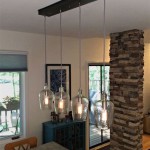Height for Dining Room Chandelier: A Comprehensive Guide
Selecting the appropriate height for a dining room chandelier is a crucial aspect of interior design, impacting both the aesthetics and functionality of the space. A poorly positioned chandelier can disrupt the visual harmony of the room, create glare, or even obstruct sightlines. This guide provides a detailed examination of the key considerations for determining the optimal height for your dining room chandelier, ensuring a balanced and well-lit dining environment.
Understanding the Impact of Chandelier Height
The height of a dining room chandelier significantly influences several factors, including the room's overall ambiance, light distribution, and the comfort of individuals seated at the dining table. A chandelier hung too high may appear disconnected from the table and fail to provide adequate task lighting. Conversely, a chandelier hung too low can obstruct views and create a claustrophobic feeling. Proper height placement ensures a comfortable and visually appealing dining experience.
Aesthetically, the chandelier serves as a focal point in the dining room. Its positioning relative to the table and surrounding furniture contributes to the room's overall design coherence. A correctly hung chandelier enhances the room's style and complements its architectural features. Functionally, the chandelier provides illumination for dining and related activities. The height should be adjusted to minimize glare and shadows, ensuring sufficient light for both tasks and ambiance.
Key Considerations for Chandelier Height Determination
Several factors must be considered when determining the appropriate height for a dining room chandelier. These factors include the ceiling height, table size and shape, chandelier dimensions, and personal preferences. A thorough assessment of these elements is essential for achieving the optimal balance between aesthetics and functionality.
Ceiling Height: The ceiling height is perhaps the most critical factor in determining the chandelier's ideal placement. In general, for standard 8-foot ceilings, the bottom of the chandelier should hang approximately 30 to 36 inches above the dining table. This measurement allows ample headroom while ensuring the chandelier effectively illuminates the table. For ceilings higher than 8 feet, the chandelier should be hung proportionally higher. As a general rule, add approximately 3 inches of height for each additional foot of ceiling height. For example, in a room with a 10-foot ceiling, the chandelier should hang approximately 36 to 42 inches above the table.
Table Size and Shape: The size and shape of the dining table also influence the optimal chandelier height. A larger table typically requires a larger chandelier, which may necessitate a slightly higher hanging position to avoid overwhelming the space. Similarly, the shape of the table can impact light distribution. For instance, a long rectangular table might benefit from a chandelier with a linear design, hung at a height that evenly distributes light across the entire surface. Smaller, round tables may pair well with smaller, more compact chandeliers, hung at a slightly lower height to create a more intimate atmosphere.
Chandelier Dimensions: The chandelier's dimensions, including its height and width, should be proportional to the size of the dining room and the dining table. A chandelier that is too large for the space can feel overwhelming, while one that is too small may appear insignificant. As a general guideline, the diameter of the chandelier (in inches) should be approximately half the width of the dining table (in inches). The height of the chandelier should also be in proportion to its diameter, ensuring a balanced and harmonious appearance. Consider the overall visual weight of the chandelier; a particularly heavy or ornate design may require a slightly higher hanging position to avoid visually compressing the space.
Personal Preferences: While general guidelines provide a useful starting point, personal preferences also play a significant role in determining the optimal chandelier height. Some individuals may prefer a lower-hanging chandelier to create a more intimate and dramatic ambiance, while others may prefer a higher-hanging chandelier for a more open and airy feel. It is important to experiment with different heights and observe how the light and overall aesthetic are affected. Consider the specific lighting needs of the dining room. If the chandelier is the primary source of light, it may need to be hung slightly lower to provide adequate illumination. If the dining room has ample natural light or supplemental lighting, the chandelier can be hung slightly higher for a more decorative effect.
Step-by-Step Guide to Determining Chandelier Height
To accurately determine the optimal height for your dining room chandelier, follow these steps:
Step 1: Measure Ceiling Height: Accurately measure the height of the ceiling from the floor to the lowest point. This measurement is crucial for establishing the initial range for chandelier height.
Step 2: Measure Table Height: Measure the height of the dining table from the floor to the top of the table surface. This measurement is necessary to calculate the distance between the table and the bottom of the chandelier.
Step 3: Calculate Initial Hanging Height: Using the general guidelines, determine the initial hanging height for the chandelier. For an 8-foot ceiling, aim for 30 to 36 inches above the table. Adjust this measurement based on the ceiling height, adding approximately 3 inches for each additional foot of ceiling height.
Step 4: Consider Chandelier Dimensions: Take into account the dimensions of the chandelier itself. A larger or more ornate chandelier may require a slightly higher hanging position to avoid overwhelming the space. Ensure that the chandelier's diameter is proportional to the width of the dining table.
Step 5: Temporarily Hang the Chandelier: If possible, temporarily hang the chandelier at the calculated height. This allows you to visually assess the placement and make any necessary adjustments. Use a temporary hanging mechanism that is strong enough to support the chandelier's weight.
Step 6: Assess Sightlines and Obstructions: While the chandelier is temporarily hung, sit at the dining table and assess sightlines. Ensure that the chandelier does not obstruct views or create a feeling of claustrophobia. Walk around the room and observe the chandelier from different angles to ensure that it is visually appealing from all perspectives.
Step 7: Adjust Height as Needed: Based on your observations, adjust the height of the chandelier as needed. Raise or lower the chandelier in small increments (e.g., 2-3 inches at a time) until you achieve the desired balance between aesthetics and functionality.
Step 8: Securely Install the Chandelier: Once you are satisfied with the chandelier's height, securely install it according to the manufacturer's instructions. Ensure that the electrical connections are properly made and that the chandelier is securely attached to the ceiling.
Addressing Specific Scenarios
Certain dining room configurations may require adjustments to the standard guidelines for chandelier height. These scenarios include rooms with vaulted ceilings, multi-tiered chandeliers, and unconventional table shapes.
Vaulted Ceilings: In dining rooms with vaulted ceilings, the chandelier should be hung at a height that is proportional to the ceiling's slope and height. Since vaulted ceilings are inherently higher, the chandelier can be hung significantly lower than in a room with a standard ceiling height. The key is to ensure that the chandelier is visually balanced within the space and does not appear to be dwarfed by the ceiling's height. If the vaulted ceiling is particularly high, consider using a longer chain or downrod to bring the chandelier closer to the dining table.
Multi-Tiered Chandeliers: Multi-tiered chandeliers can add a dramatic and elegant touch to a dining room. However, their height can be challenging to determine. When hanging a multi-tiered chandelier, focus on the lowest tier as the reference point for height. The lowest tier should be approximately 30 to 36 inches above the dining table (or higher for taller ceilings). Ensure that the overall height of the chandelier is proportional to the room's dimensions and does not overwhelm the space.
Unconventional Table Shapes: Dining tables with unconventional shapes, such as oval or freeform designs, may require a more flexible approach to chandelier placement. In these cases, focus on centering the chandelier over the main seating area of the table. The height should be adjusted to provide adequate light for all diners and to complement the table's unique shape. Consider using multiple smaller chandeliers or pendant lights to provide more even illumination across the table surface.
Properly determining the height for a dining room chandelier involves careful consideration of multiple factors. By understanding the impact of chandelier height, assessing key considerations, and following the step-by-step guide, individuals can achieve optimal placement that enhances both the aesthetics and functionality of their dining room.

Dining Room Chandelier Size Guide Delmarfans Com

Ace Wrought Iron Chandelier Size And Height Guide

How High Should My Light Fixture Hang Above Dining Table Schoolhouse

How High Should You Hang Your Dining Room Chandelier Arched Manor

Image Result For Light Fixtures Height Over Dining Table

How To Hang A Chandelier At The Perfect Height Over Dining Table Mod Lighting

The Perfect Height For Your Dining Room Chandelier

Illuminating Elegance A Guide To Choosing The Perfect Chandelier Size For Your Modern Dining Table

How To Size A Dining Room Chandelier 3 Easy Steps

How High Should You Hang Your Dining Room Chandelier Arched Manor








